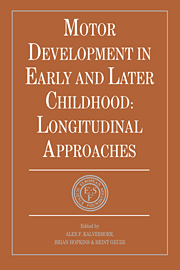Book contents
- Frontmatter
- Contents
- List of contributors
- Foreword
- Preface
- SETTING THE SCENE
- SECTION I BIOLOGICAL BASIS OF MOTOR DEVELOPMENT
- SECTION II DEVELOPMENT OF BODY POSTURE AND GOAL-DIRECTED REACHING
- SECTION III MOTOR DEVELOPMENT, EARLY COMMUNICATION AND COGNITION
- SECTION IV ACQUISITION OF SKILLS
- SECTION V MOTOR DEVELOPMENT AND HANDICAP
- 16 Early motor development in term and preterm children
- 17 Relationship between perinatal risk factors and motor development at the ages of 5 and 9 years
- 18 Motor development and minor handicap
- 19 Longitudinal and cross-sectional approaches in experimental studies in motor development
- SECTION VI METHODOLOGICAL AND CONCEPTUAL CONSIDERATIONS
- Epilogue: description versus explanation
- Index
16 - Early motor development in term and preterm children
from SECTION V - MOTOR DEVELOPMENT AND HANDICAP
Published online by Cambridge University Press: 05 May 2010
- Frontmatter
- Contents
- List of contributors
- Foreword
- Preface
- SETTING THE SCENE
- SECTION I BIOLOGICAL BASIS OF MOTOR DEVELOPMENT
- SECTION II DEVELOPMENT OF BODY POSTURE AND GOAL-DIRECTED REACHING
- SECTION III MOTOR DEVELOPMENT, EARLY COMMUNICATION AND COGNITION
- SECTION IV ACQUISITION OF SKILLS
- SECTION V MOTOR DEVELOPMENT AND HANDICAP
- 16 Early motor development in term and preterm children
- 17 Relationship between perinatal risk factors and motor development at the ages of 5 and 9 years
- 18 Motor development and minor handicap
- 19 Longitudinal and cross-sectional approaches in experimental studies in motor development
- SECTION VI METHODOLOGICAL AND CONCEPTUAL CONSIDERATIONS
- Epilogue: description versus explanation
- Index
Summary
INTRODUCTION
In infants and young children at risk for motor disturbances, clinicians are interested in the temporal occurrence and pathways of motor behaviours, the quality of motor performance as an expression of neurological integrity, and adverse events which may affect motor development. The following questions are of particular clinical importance:
Is there one pathway or are there different pathways of early motor development in normal children?
Is motor development dependent on conceptional or chronological age? Has age to be corrected for prematurity in order for an accurate judgement of motor development to be made?
How does cerebral damage effect the age-related course and pathways of motor development?
How do neurological functions (e.g. tendon reflexes, muscle tone) relate to age-dependent measures of motor development (e.g. onset of walking)? Does this relationship change over age?
To what extent is motor development influenced by prenatal, perinatal and postnatal factors?
Is the onset and sequencing in motor development stable over generations?
Most of these clinically relevant aspects of early motor development can be analysed only in a longitudinal manner (Wohlwill, 1973). The aim of this chapter is to address these questions on the basis of the data of the Zurich longitudinal studies.
- Type
- Chapter
- Information
- Motor Development in Early and Later ChildhoodLongitudinal Approaches, pp. 247 - 265Publisher: Cambridge University PressPrint publication year: 1993
- 6
- Cited by



